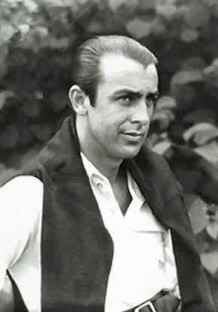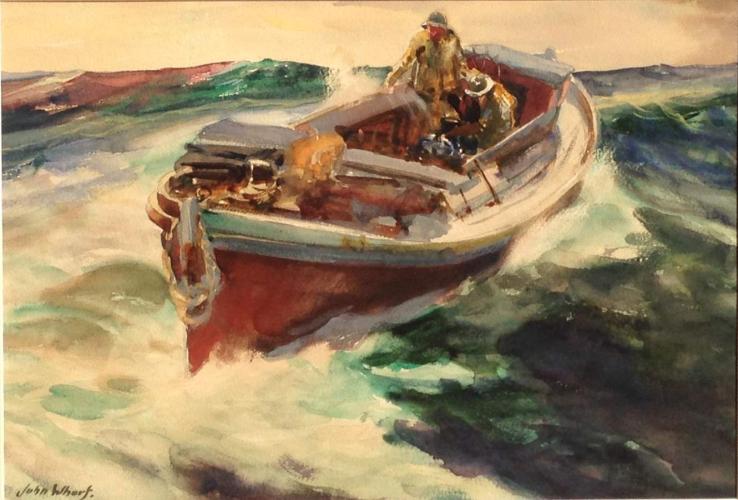Inquire about Fisherman at Sea by John Whorf
Share Fisherman at Sea by John Whorf
John Whorf
-
Title: Fisherman at Sea -
Inventory#: WHORJ1100006 -
Size: 14" x 21" -
Frame Size: 23" x 28" -
Medium: Watercolor -
Price: $8,500 -
Next Items Preview

John Whorf (1903-1959)
Restless, precocious, talented, opinionated, and quite possibly a big pain in the ass to the more conservative folks in his presence, John Whorf achieved remarkable success, a devoted following of art lovers and voyeurs wanting to hear about his latest adventures—and all at a very young age. An artistic father encouraged the youngster at fourteen years old to study at St. Botolph Studio and the MFA. Within a year he left, convinced that independent experimentation and trial and error were a better way to learn. Abandoning the dry academies of Boston, and not yet fifteen years old, Whorf headed to Provincetown, Massachusetts, where his family roots lay. An extraordinary collection of artists, writers and thinkers collected in “P-Town” in 1917, many were artist refugees from World War I who fled Europe and settled in Provincetown. The youngster began study with Charles Hawthorne and George Elmer Brown and hung out at the famed Beachcombers Social Club with older artists Richard Miller and Gerrit Beneker. Whorf could not have been happier—the whole bohemian environment must have been electric. At eighteen years old, a serious injury from a fall resulted in a period of paralysis and years requiring the use of a cane. But Whorf focused his energies from being “a dancing hound”1 into his art. After his recovery and extensive travels in Europe, where he decided watercolor would be his medium of choice and best suited to his travels and spontaneous temperament, he returned to the United States. At age twenty-one he held his first one-man show at Grace Horne Gallery in Boston; the reviewers raved, the watercolors sold out, and the reigning king of watercolor John Singer Sargent purchased his work. Instantly Whorf was, as they say in the movies, a “made man,” and fame, good fortune and legions of admirers followed his career and one-man shows throughout the rest of his life. In 1976, when I acquired this major and—as the years ahead confirmed—rare oil, I was unaware of how the medium of watercolor would dominate John Whorf’s reputation. Nevertheless, this amazingly gutsy harbor interior proves that this artist could really paint in oils as well. In recent years occasional oils have emerged in galleries and auctions and have been eagerly sought after, perhaps because of the rarity or just because they are good.
Although John Whorf was a competent post-impressionist oil painter he is considered one of the finest American watercolorists from the early 20th century and his work is highly sought after. His artistic style was most influenced by John Singer Sargent and Frank W. Benson. His landscapes of the four seasons in and around New England are spontaneously executed and his favorite locale was Provincetown at the tip of Cape Cod.
Whorf was born in Winthrop, MA in 1903 and died in Provincetown in 1959. He studied with his father Harry C. Whorf; at the St. Botolph Studio in Boston with Sherman Kidd at the age of 14; at Boston's Museum School with William James and Philip Leslie Hale in 1917; and in Provincetown after 1917-1918 with Charles W. Hawthorne; with Max Bohm, Richard Miller, Garrett Beneker, George Elmer Browne and E.A. Webster in Provincetown; and in Paris after 1919 at the Academy de la Grande Chaumiere, the Ecole des Beaux Arts and the Academie Colarossi and with John Singer Sargent in Boston as late as 1924-1925.
Whorf was an Associate and a full Academician of the National Academy of Design (1947) and a member of the American Water Color Society; the Florida Water Color Society; The Beachcombers; and the Provincetown Art Association. He was given his first solo exhibition in 1924 at the Grace Horne Gallery in Boston and the Milch Galleries in New York gave him 32 solo exhibitions. Awards include medals the California Water Color Society; Art Institute of Chicago (1939, 1943) and an honorary M.A. from Harvard University in 1939.
The artist's work is represented at Museum of Fine Arts (Boston); Metropolitan Museum of Art; M.I.T.; Fogg Art Museum; Addison Gallery of American Art; Amherst College Art Museum; John Herron Art Institute; Museum of Modern Art; Los Angeles County Museum; Worcester Art Museum; Montclair Art Museum; Art Institute of Chicago; RI School of Design; Corcoran Gallery of Art; St. Louis Museum of Art; Butler Art Institute; National Museum, Stockholm, Sweden; Pitti Palace, Florence, Italy; Yale University; Baltimore Museum of Art; Hickory Museum of Art; St. Louis Museum of Art; Whitney Museum of American Art and more.
References: Falk, Who Was Who in American Art (vol. iii); American Art Annual, "Who's Who in American Art," through 1940; 1937, Logan, J.H., Sanity in Art; 1922, Art Institute of Chicago, A Century of Progress; 1945, Crane, Aimee, Portrait of America; 1954, Eliot Clark, History of the National Academy of Design; 1969, Perry Rathbone, American Paintings at the Museum of Fine Arts; 1977, Provincetown Painters, Everson Museum of Art; 1975, Bruce Chambers, American Paintings at the High Museum of Art; 1977, D. Hoopes, American Watercolor Painting


Fisherman at Sea
John Whorf
Watercolor
14" x 21" Framed: 23" x 28"
$8,500
Prices and availability may change without prior notice.
A price quote alone does not constitute a hold on the item.
All items remain property of Granary Gallery until paid in full.
A price quote alone does not constitute a hold on the item.
All items remain property of Granary Gallery until paid in full.
Granary Gallery | 636 Old County Road, West Tisbury, MA 02575 | (508)693-0455 | granarygallery.com




